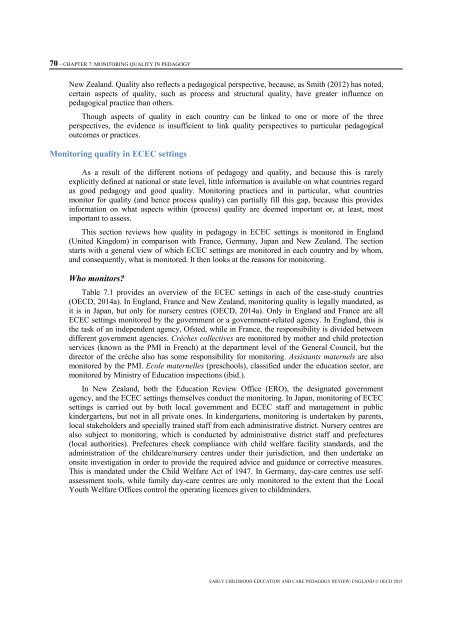early-childhood-education-and-care-pedagogy-review-england.pdf?utm_content=bufferb49b1&utm_medium=social&utm_source=twitter
early-childhood-education-and-care-pedagogy-review-england.pdf?utm_content=bufferb49b1&utm_medium=social&utm_source=twitter
early-childhood-education-and-care-pedagogy-review-england.pdf?utm_content=bufferb49b1&utm_medium=social&utm_source=twitter
You also want an ePaper? Increase the reach of your titles
YUMPU automatically turns print PDFs into web optimized ePapers that Google loves.
70 – CHAPTER 7: MONITORING QUALITY IN PEDAGOGYNew Zeal<strong>and</strong>. Quality also reflects a pedagogical perspective, because, as Smith (2012) has noted,certain aspects of quality, such as process <strong>and</strong> structural quality, have greater influence onpedagogical practice than others.Though aspects of quality in each country can be linked to one or more of the threeperspectives, the evidence is insufficient to link quality perspectives to particular pedagogicaloutcomes or practices.Monitoring quality in ECEC settingsAs a result of the different notions of <strong>pedagogy</strong> <strong>and</strong> quality, <strong>and</strong> because this is rarelyexplicitly defined at national or state level, little information is available on what countries regardas good <strong>pedagogy</strong> <strong>and</strong> good quality. Monitoring practices <strong>and</strong> in particular, what countriesmonitor for quality (<strong>and</strong> hence process quality) can partially fill this gap, because this providesinformation on what aspects within (process) quality are deemed important or, at least, mostimportant to assess.This section <strong>review</strong>s how quality in <strong>pedagogy</strong> in ECEC settings is monitored in Engl<strong>and</strong>(United Kingdom) in comparison with France, Germany, Japan <strong>and</strong> New Zeal<strong>and</strong>. The sectionstarts with a general view of which ECEC settings are monitored in each country <strong>and</strong> by whom,<strong>and</strong> consequently, what is monitored. It then looks at the reasons for monitoring.Who monitors?Table 7.1 provides an overview of the ECEC settings in each of the case-study countries(OECD, 2014a). In Engl<strong>and</strong>, France <strong>and</strong> New Zeal<strong>and</strong>, monitoring quality is legally m<strong>and</strong>ated, asit is in Japan, but only for nursery centres (OECD, 2014a). Only in Engl<strong>and</strong> <strong>and</strong> France are allECEC settings monitored by the government or a government-related agency. In Engl<strong>and</strong>, this isthe task of an independent agency, Ofsted, while in France, the responsibility is divided betweendifferent government agencies. Crèches collectives are monitored by mother <strong>and</strong> child protectionservices (known as the PMI in French) at the department level of the General Council, but thedirector of the crèche also has some responsibility for monitoring. Assistants maternels are alsomonitored by the PMI. Ecole maternelles (preschools), classified under the <strong>education</strong> sector, aremonitored by Ministry of Education inspections (ibid.).In New Zeal<strong>and</strong>, both the Education Review Office (ERO), the designated governmentagency, <strong>and</strong> the ECEC settings themselves conduct the monitoring. In Japan, monitoring of ECECsettings is carried out by both local government <strong>and</strong> ECEC staff <strong>and</strong> management in publickindergartens, but not in all private ones. In kindergartens, monitoring is undertaken by parents,local stakeholders <strong>and</strong> specially trained staff from each administrative district. Nursery centres arealso subject to monitoring, which is conducted by administrative district staff <strong>and</strong> prefectures(local authorities). Prefectures check compliance with child welfare facility st<strong>and</strong>ards, <strong>and</strong> theadministration of the child<strong>care</strong>/nursery centres under their jurisdiction, <strong>and</strong> then undertake anonsite investigation in order to provide the required advice <strong>and</strong> guidance or corrective measures.This is m<strong>and</strong>ated under the Child Welfare Act of 1947. In Germany, day-<strong>care</strong> centres use selfassessmenttools, while family day-<strong>care</strong> centres are only monitored to the extent that the LocalYouth Welfare Offices control the operating licences given to childminders.EARLY CHILDHOOD EDUCATION AND CARE PEDAGOGY REVIEW: ENGLAND © OECD 2015



